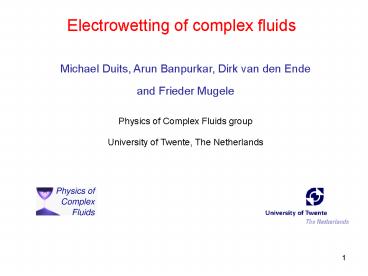Electrowetting of complex fluids - PowerPoint PPT Presentation
1 / 17
Title: Electrowetting of complex fluids
1
Electrowetting of complex fluids
Michael Duits, Arun Banpurkar, Dirk van den Ende
and Frieder Mugele Physics of Complex Fluids
group University of Twente, The Netherlands
2
Motivation
- increasing use of composite (bio)fluids in
digital microfluidics - - can adsorption and fouling be prevented?
- - could rheological properties of the fluid
preclude actuation? - increasing functionality of microfluidics
- - could surface tension, rheo properties be
measured in droplets?
Electrowetting study on gelatinated droplets
3
ElectroWetting on Gelatin
Gelatin protein, derived from collagen.
Transition from viscous liquid to elastic gel
_at_Tgel Tgel depends on concentration, salt,
molar mass, In gel state no equilibrium but
slow evolution Large deformations are sustained
(crit. strain 1)
1.conditions for repeatable, reproducible EW
experiments? 2.interfacial tension of liquid
gelatin measurable with EW? 3.elastic modulus of
gels measurable with EW?
4
1. Reproducibility test
2 gelatin/water at 40 oC (gt Tgel) Teflon AF
insulator oil bath 1kHz AC
5
2. Interfacial tension measurements
electrowetting equation
Liquid Interface EW drop tensiometer Du Noüy ring
H2O/silicone oil calibration 38 0.2 mN/m
Gelatin (2 ) / mineral oil 24.1?0.6 mN/m 23.3 0.4
Gelatin (2 ) / silicone oil 20.1?0.8 mN/m 20.2 0.5
6
3. Measuring the elastic modulus
7
Qualitative result liquid vs gel drop
increased stiffness ? reduced contact angle
variation
8
Rheology of Gelatin
Macro-rheology Electro-wetting
9
Experimental Protocol
Voltage
waiting time for thermal equilibration
and for gel formation
0
Contact angle
TY
Time
10
Also contact-free measurement
interdigitated electrodes
11
Results ElectroWetting curves
5 w gelatin V15 µL slv19 mJ/m2
40C
18C
increasing stiffness ? reduced contact angle
variation
12
How to model this behavior?
slightly deformed elastic sphere ? Hertz model
correction
13
How to model this behavior? (2)
? G 15K Pa
14
Comparison to experiment
T 25C
T 18C
5 gel
15
Elastic moduli
5 gel
16
Gel-formation-time aspect
typical time for gel formation 10-20 minutes
17
Summary
- EW is a quantitative tool for interfacial
measurements with complex fluids for sample
volumes down to nL - EW response of microdrops reflects material
elasticity, for soft materials (G 10-1000 Pa) - to do
- other model systems
- improvement of elastic model
- extension to oscillatory measurements
- extension to interfacial rheology
e??a??st? p??? !































